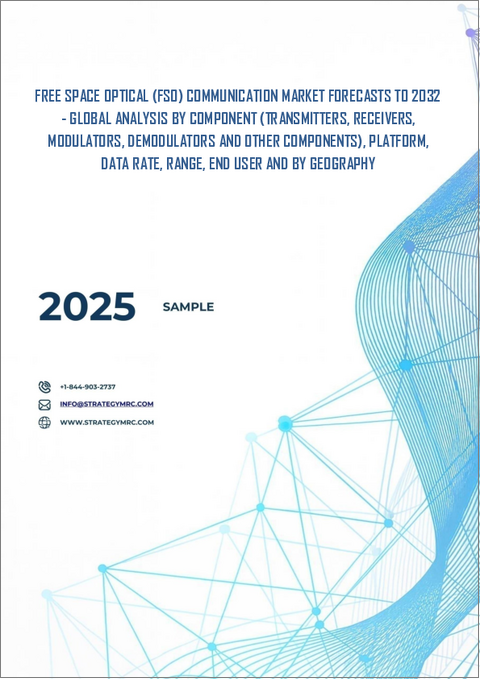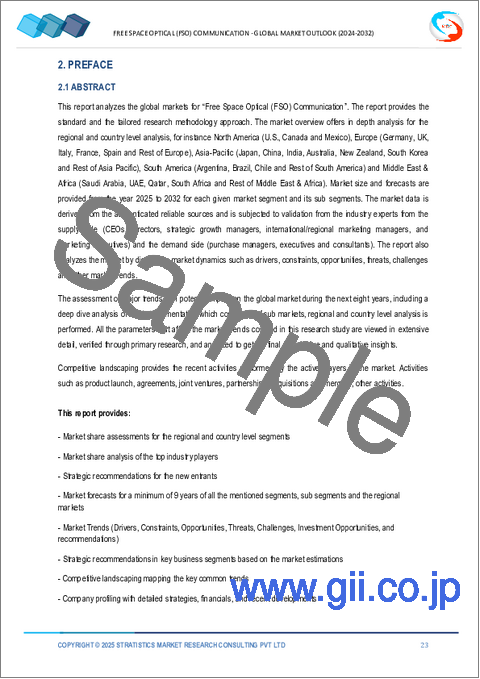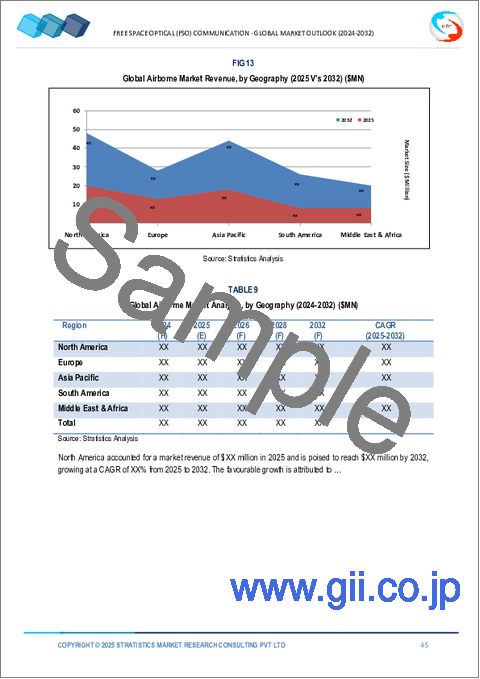|
|
市場調査レポート
商品コード
1725084
自由空間光(FSO)通信市場の2032年までの予測: コンポーネント別、プラットフォーム別、データレート別、範囲別、エンドユーザー別、地域別の世界分析Free Space Optical (FSO) Communication Market Forecasts to 2032 - Global Analysis By Component (Transmitters, Receivers, Modulators, Demodulators and Other Components), Platform, Data Rate, Range, End User and By Geography |
||||||
カスタマイズ可能
|
|||||||
| 自由空間光(FSO)通信市場の2032年までの予測: コンポーネント別、プラットフォーム別、データレート別、範囲別、エンドユーザー別、地域別の世界分析 |
|
出版日: 2025年05月03日
発行: Stratistics Market Research Consulting
ページ情報: 英文 200+ Pages
納期: 2~3営業日
|
全表示
- 概要
- 図表
- 目次
Stratistics MRCによると、世界の自由空間光(FSO)通信市場は、2025年に10億9,710万米ドルを占め、予測期間中のCAGRは33.3%で成長し、2032年には82億510万米ドルに達すると予測されています。
FSO通信は、通常レーザー光線や赤外線を使用し、大気中を通過する2地点間のデータ転送に光を使用することで、物理的な配線を不要にする方法です。この光無線通信技術では高速データ転送が可能で、特に配線が困難な場所や遠隔地では、従来の光ファイバー通信や無線周波数通信に代わる優れた通信手段として注目されています。気象条件が影響することもあるが、FSOシステムは短・中距離通信ではかなりの成功を収めており、高帯域幅、セキュリティ、最小限のインフラ・コストなどの利点があります。
高速で安全な通信
FSO技術は、物理的な接続を使用せずに迅速なデータ転送を実現するため、広帯域幅のアプリケーションに最適です。従来の通信技術に比べ、視線方向の伝送であるため傍受が難しく、セキュリティ面でも優れています。安全で効率的な通信に対する需要が高まるにつれ、FSOは都市部や遠隔地において、光ファイバーに代わる現実的な選択肢を提示しています。この技術の拡大は、通信、航空宇宙、防衛などの分野でリアルタイムのデータ転送を促進する能力によってさらに加速しています。レーザー技術の開発と統合能力の向上により、FSO通信は安全で高速なデータ・ネットワークの重要な実現手段として進化し続けています。
環境条件の影響を受けやすい
光信号は、霧、雨、雪などの気象条件によって吸収されたり、散乱されたりすると、効果が低下します。信号強度の変動は、熱波などの大気の乱れによっても引き起こされます。汚染物質、煙、埃はさらに光路を遮り、信号の質を低下させる。FSO通信システムの信頼性は、このような環境問題によって制限されます。このため、天候不順な地域の消費者は深刻な性能問題を経験し、この技術の普及を妨げています。
スマートシティ構想への採用
リアルタイムのデータと通信はスマート・シティのインフラに不可欠であり、FSOは従来の光ファイバー・システムに代わる安価な代替手段を提供します。都市環境におけるIoTデバイスやスマート・センサーのニーズの高まりは、見通し線上のネットワークで広帯域幅を提供するFSOの能力によって支えられています。FSOは、特に混雑した都市部での展開に柔軟性があるため、スマートシティ接続に最適なオプションです。また、FSOシステムは拡張性に優れているため、コミュニティは物理的なインフラを大幅に調整することなく、ネットワークを拡大することができます。スマートシティ構想におけるFSOの導入は、効率的で持続可能な技術が重視されるようになったことで、さらに加速しています。
市民の意識と理解
安全な通信や高速データ転送など、FSOの利点はあまり知られていないです。この無知が、この技術の導入に対する不信感や抵抗感を生んでいます。潜在的な利用者は、天候に左右されやすいといった技術的限界に関する誤解によって、しばしば落胆します。このため、企業や顧客は、より確立された通信手段を選好する可能性があります。これを克服するためには、FSOの利点と実際の使用方法についての知識と指導を増やすことが市場成長には不可欠です。
COVID-19の影響
COVID-19パンデミックは、当初、ロックダウン、サプライチェーンの中断、インフラ配備の遅れにより、自由空間光(FSO)通信市場を混乱させました。しかし、遠隔作業、遠隔医療、デジタル通信の急増により、高速で安全な無線接続の必要性が浮き彫りになりました。この変化は、その迅速な展開と広帯域幅機能により、特に企業や防衛分野でのFSO採用を加速させました。その結果、市場は2021年以降に力強く回復し、信頼性の高いファイバーライクな無線通信ソリューションの需要増に牽引されて持続的な成長が予測されています。
予測期間中、トランスミッタセグメントが最大になる見込み
予測期間中、光回線による高速データ伝送により、トランスミッタセグメントが最大の市場シェアを占めると予想されます。防衛、通信、航空宇宙など様々な産業で、より高速で信頼性の高い通信システムが求められていることが、高度なトランスミッタの成長を後押ししています。これらのデバイスは、より高いデータレートや改善された変調フォーマットなどの強化された機能を提供し、FSOの効率を高めています。安全でコスト効率に優れた通信ソリューションへのニーズが高まる中、トランスミッタはFSO技術を従来の無線通信に代わる魅力的な選択肢とするのに役立っています。この技術的進歩は、世界のFSO通信システムの拡大と採用に大きく貢献しています。
予測期間中、ヘルスケア分野のCAGRが最も高くなる見込み
予測期間中、ヘルスケア分野は遠隔医療や遠隔患者モニタリングシステムの強化により、最も高い成長率を記録すると予測されています。FSO技術は、高速、安全、干渉のないデータ伝送を保証し、これは医療データ交換や診察に不可欠です。患者データにリアルタイムでアクセスする必要性が高まるにつれ、FSOによってヘルスケアプロバイダーは遠隔地やサービスが行き届いていない地域でも効率的なサービスを提供できるようになります。電子カルテ(EHR)やデジタル・ヘルス・プラットフォームの採用が進むにつれ、信頼性の高い通信システムへの需要がさらに高まっています。さらに、FSOは大規模な物理的インフラの必要性を減らすことで、ヘルスケア施設にコスト効率の高いソリューションを提供します。
最大シェアの地域
予測期間中、アジア太平洋は、環境意識の高まり、従来のプラスチックに対する政府規制の増加、持続可能なパッケージング・ソリューションに対する需要の急増により、最大の市場シェアを占めると予想されます。中国、インド、日本、韓国などの国々では、生分解性プラスチック技術への投資が活発化しています。拡大する飲食品業界と拡大するeコマースと小売部門は、環境に優しい包装材料への需要をさらに煽っています。技術の進歩と環境に優しい代替品への支援により、アジア太平洋地域はデンプン系プラスチックの技術革新と採用の重要な拠点となっています。
CAGRが最も高い地域:
予測期間中、北米地域が最も高いCAGRを示すと予想されるが、これは従来の石油ベースのプラスチックに代わる、環境に優しく生分解性のある代替品への需要が高まっているためです。同地域の持続可能性への関心の高まりは、厳しい環境規制と相まって、デンプンベースのプラスチック生産の技術革新に拍車をかけています。包装、農業、食品サービスなどの主要セクターは、二酸化炭素排出量の削減と分解能力の高さから、これらのバイオベースプラスチックを積極的に採用しています。技術の進歩と生産プロセスの改善により、北米では今後もデンプン系プラスチックの利用が拡大する見通しです。
無料のカスタマイズサービス
本レポートをご購読のお客様には、以下の無料カスタマイズオプションのいずれかをご利用いただけます:
- 企業プロファイル
- 追加市場企業の包括的プロファイリング(3社まで)
- 主要企業のSWOT分析(3社まで)
- 地域セグメンテーション
- 顧客の関心に応じた主要国の市場推計・予測・CAGR(注:フィージビリティチェックによる)
- 競合ベンチマーキング
- 製品ポートフォリオ、地理的プレゼンス、戦略的提携に基づく主要企業のベンチマーキング
目次
第1章 エグゼクティブサマリー
第2章 序文
- 概要
- ステークホルダー
- 調査範囲
- 調査手法
- データマイニング
- データ分析
- データ検証
- 調査アプローチ
- 調査資料
- 1次調査資料
- 2次調査情報源
- 前提条件
第3章 市場動向分析
- 促進要因
- 抑制要因
- 機会
- 脅威
- エンドユーザー分析
- 新興市場
- COVID-19の影響
第4章 ポーターのファイブフォース分析
- 供給企業の交渉力
- 買い手の交渉力
- 代替品の脅威
- 新規参入業者の脅威
- 競争企業間の敵対関係
第5章 世界の自由空間光通信(FSO)市場:コンポーネント別
- 送信機
- 受信機
- 変調器
- 復調器
- エンコーダとデコーダ
- その他のコンポーネント
第6章 世界の自由空間光通信(FSO)市場:プラットフォーム別
- 地上
- 空挺
- 宇宙船
- 海事
- その他のプラットフォーム
第7章 世界の自由空間光通信(FSO)市場:データレート別
- 最大1Gbps
- 1Gbps~10Gbps
- 10Gbps以上
第8章 世界の自由空間光通信(FSO)市場:範囲別
- 短距離
- 中距離
- 長距離
第9章 世界の自由空間光通信(FSO)市場:エンドユーザー別
- 航空宇宙および防衛
- 通信
- ヘルスケア
- ITとアイテム
- 政府
- コマーシャル
- 教育
- その他のエンドユーザー
第10章 世界の自由空間光通信(FSO)市場:地域別
- 北米
- 米国
- カナダ
- メキシコ
- 欧州
- ドイツ
- 英国
- イタリア
- フランス
- スペイン
- その他の欧州
- アジア太平洋
- 日本
- 中国
- インド
- オーストラリア
- ニュージーランド
- 韓国
- その他のアジア太平洋
- 南米
- アルゼンチン
- ブラジル
- チリ
- その他の南米
- 中東・アフリカ
- サウジアラビア
- アラブ首長国連邦
- カタール
- 南アフリカ
- その他の中東・アフリカ
第11章 主な発展
- 契約、パートナーシップ、コラボレーション、ジョイントベンチャー
- 買収と合併
- 新製品発売
- 事業拡大
- その他の主要戦略
第12章 企業プロファイリング
- Mynaric AG
- Cailabs
- Thales Alenia Space
- Kepler Communications
- Stellar Project
- AOptix Technologies
- LightPointe Communications
- fSONA Networks Corporation
- Plaintree Systems Inc.
- Oledcomm
- Wireless Excellence Ltd.
- SkyFiber
- Mostcom Ltd.
- Trimble Hungary Kft
- Koninklijke Philips N.V.
- General Electric Co.
- L3 Technologies
- ADVA Optical Networking SE
List of Tables
- Table 1 Global Free Space Optical (FSO) Communication Market Outlook, By Region (2024-2032) ($MN)
- Table 2 Global Free Space Optical (FSO) Communication Market Outlook, By Component (2024-2032) ($MN)
- Table 3 Global Free Space Optical (FSO) Communication Market Outlook, By Transmitters (2024-2032) ($MN)
- Table 4 Global Free Space Optical (FSO) Communication Market Outlook, By Receivers (2024-2032) ($MN)
- Table 5 Global Free Space Optical (FSO) Communication Market Outlook, By Modulators (2024-2032) ($MN)
- Table 6 Global Free Space Optical (FSO) Communication Market Outlook, By Demodulators (2024-2032) ($MN)
- Table 7 Global Free Space Optical (FSO) Communication Market Outlook, By Encoders & Decoders (2024-2032) ($MN)
- Table 8 Global Free Space Optical (FSO) Communication Market Outlook, By Other Components (2024-2032) ($MN)
- Table 9 Global Free Space Optical (FSO) Communication Market Outlook, By Platform (2024-2032) ($MN)
- Table 10 Global Free Space Optical (FSO) Communication Market Outlook, By Terrestrial (2024-2032) ($MN)
- Table 11 Global Free Space Optical (FSO) Communication Market Outlook, By Airborne (2024-2032) ($MN)
- Table 12 Global Free Space Optical (FSO) Communication Market Outlook, By Spaceborne (2024-2032) ($MN)
- Table 13 Global Free Space Optical (FSO) Communication Market Outlook, By Maritime (2024-2032) ($MN)
- Table 14 Global Free Space Optical (FSO) Communication Market Outlook, By Other Platforms (2024-2032) ($MN)
- Table 15 Global Free Space Optical (FSO) Communication Market Outlook, By Data Rate (2024-2032) ($MN)
- Table 16 Global Free Space Optical (FSO) Communication Market Outlook, By Up to 1 Gbps (2024-2032) ($MN)
- Table 17 Global Free Space Optical (FSO) Communication Market Outlook, By 1 Gbps to 10 Gbps (2024-2032) ($MN)
- Table 18 Global Free Space Optical (FSO) Communication Market Outlook, By Above 10 Gbps (2024-2032) ($MN)
- Table 19 Global Free Space Optical (FSO) Communication Market Outlook, By Range (2024-2032) ($MN)
- Table 20 Global Free Space Optical (FSO) Communication Market Outlook, By Short Range (2024-2032) ($MN)
- Table 21 Global Free Space Optical (FSO) Communication Market Outlook, By Medium Range (2024-2032) ($MN)
- Table 22 Global Free Space Optical (FSO) Communication Market Outlook, By Long Range (2024-2032) ($MN)
- Table 23 Global Free Space Optical (FSO) Communication Market Outlook, By End User (2024-2032) ($MN)
- Table 24 Global Free Space Optical (FSO) Communication Market Outlook, By Aerospace & Defense (2024-2032) ($MN)
- Table 25 Global Free Space Optical (FSO) Communication Market Outlook, By Telecommunications (2024-2032) ($MN)
- Table 26 Global Free Space Optical (FSO) Communication Market Outlook, By Healthcare (2024-2032) ($MN)
- Table 27 Global Free Space Optical (FSO) Communication Market Outlook, By IT & ITES (2024-2032) ($MN)
- Table 28 Global Free Space Optical (FSO) Communication Market Outlook, By Government (2024-2032) ($MN)
- Table 29 Global Free Space Optical (FSO) Communication Market Outlook, By Commercial (2024-2032) ($MN)
- Table 30 Global Free Space Optical (FSO) Communication Market Outlook, By Education (2024-2032) ($MN)
- Table 31 Global Free Space Optical (FSO) Communication Market Outlook, By Other End Users (2024-2032) ($MN)
Note: Tables for North America, Europe, APAC, South America, and Middle East & Africa Regions are also represented in the same manner as above.
According to Stratistics MRC, the Global Free Space Optical (FSO) Communication Market is accounted for $1097.1 million in 2025 and is expected to reach $8205.1 million by 2032 growing at a CAGR of 33.3% during the forecast period. FSO communication is a method that eliminates the need for physical wires by using light to transfer data between two locations through the atmosphere, usually using laser beams or infrared light. High-speed data transfer rates are possible with this optical wireless communication technique, which is seen as a good substitute for conventional fibre optic and radio-frequency communications, particularly in places that are difficult to wire or remote. While weather conditions can have an impact, FSO systems are quite successful for short- to medium-range communication and offer benefits including high bandwidth, security, and minimal infrastructure costs.
Market Dynamics:
Driver:
High-speed, secure communication
FSO technology is a great option for high-bandwidth applications since it provides quick data transfer without the use of physical connections. Compared to conventional communication techniques, its line-of-sight transmission makes it more difficult to intercept, which contributes to its security advantages. As the demand for safe and efficient communication develops, FSO presents a viable alternative to fiber optics in urban and remote places. The technology's expansion is further fuelled by its capacity to facilitate real-time data transfer for sectors including telecommunications, aerospace, and defence. With developments in laser technology and greater integration capabilities, FSO communication continues to evolve as a vital enabler of secure, high-speed data networks.
Restraint:
Susceptibility to environmental conditions
Light signals can be less effective when they are absorbed or scattered by weather conditions including fog, rain, and snow. Variations in signal intensity are also caused by atmospheric turbulence, such as heat waves. Pollutants, smoke, and dust further block light pathways, resulting in low signal quality. The dependability of FSO communication systems is restricted by these environmental issues. Because of this, consumers in areas with erratic weather experience severe performance problems, which hinders the uptake of this technology.
Opportunity:
Adoption in smart city initiatives
Real-time data and communication are essential for the infrastructure of smart cities, and FSO provides an affordable substitute for conventional fibre optic systems. The increasing need for IoT devices and smart sensors in urban settings is supported by FSO's capacity to deliver high bandwidth over line-of-sight networks. It is the perfect option for smart city connectivity because of its deployment flexibility, particularly in crowded urban areas. FSO systems are also scalable, allowing communities to grow their networks without having to make major adjustments to their physical infrastructure. The implementation of FSO in smart city initiatives is further accelerated by the growing emphasis on efficient, sustainable technologies.
Threat:
Public awareness and understanding
The advantages of FSO, like secure communication and fast data transfer, are not well known. This ignorance breeds distrust and resistance to implementing the technology. Potential users are often discouraged by misconceptions regarding its technical limits, such as its sensitivity to weather conditions. Because of this, companies and customers could favour more established forms of communication. Increased knowledge and instruction of the benefits and real-world uses of FSO are essential for market growth in order to overcome this.
Covid-19 Impact
The COVID-19 pandemic initially disrupted the Free Space Optical (FSO) communication market due to lockdowns, supply chain interruptions, and delayed infrastructure deployments. However, the surge in remote work, telemedicine, and digital communication highlighted the need for high-speed, secure wireless connectivity. This shift accelerated FSO adoption, especially in enterprise and defense sectors, due to its rapid deployment and high bandwidth capabilities. Consequently, the market rebounded strongly post-2021, with projections indicating sustained growth driven by increasing demand for reliable, fiber-like wireless communication solutions.
The transmitters segment is expected to be the largest during the forecast period
The transmitters segment is expected to account for the largest market share during the forecast period, due to high-speed data transmission over optical lines of sight. The demand for faster, more reliable communication systems in various industries, including defense, telecommunications, and aerospace, drives the growth of advanced transmitters. These devices offer enhanced capabilities like higher data rates and improved modulation formats, increasing FSO's efficiency. As the need for secure and cost-effective communication solutions rises, transmitters help make FSO technology an attractive alternative to traditional wireless communication. This technological advancement contributes significantly to the expansion and adoption of FSO communication systems globally.
The healthcare segment is expected to have the highest CAGR during the forecast period
Over the forecast period, the healthcare segment is predicted to witness the highest growth rate by enhancing telemedicine and remote patient monitoring systems. FSO technology ensures high-speed, secure, and interference-free data transmission, which is crucial for medical data exchange and consultations. As the need for real-time access to patient data grows, FSO enables healthcare providers to deliver efficient services, even in remote or underserved areas. The growing adoption of electronic health records (EHR) and digital health platforms further fuels the demand for reliable communication systems. Additionally, FSO offers cost-effective solutions for healthcare facilities by reducing the need for extensive physical infrastructure.
Region with largest share:
During the forecast period, the Asia Pacific region is expected to hold the largest market share by rising environmental awareness, increasing government regulations on conventional plastics, and a surge in demand for sustainable packaging solutions. Countries like China, India, Japan, and South Korea are witnessing heightened investments in biodegradable plastic technologies. The growing food and beverage industry, along with expanding e-commerce and retail sectors, further fuel the demand for eco-friendly packaging materials. Technological advancements and support for green alternatives are positioning Asia Pacific as a key hub for starch-based plastics innovation and adoption.
Region with highest CAGR:
Over the forecast period, the North America region is anticipated to exhibit the highest CAGR, owing to the increasing demand for eco-friendly and biodegradable alternatives to traditional petroleum-based plastics. The region's heightened focus on sustainability, combined with stringent environmental regulations, has spurred innovation in starch-based plastic production. Key sectors such as packaging, agriculture, and food service are actively adopting these bio-based plastics due to their reduced carbon footprint and ability to decompose. With advancements in technology and improved production processes, North America is poised to continue expanding its use of starch-based plastics.
Key players in the market
Some of the key players profiled in the Free Space Optical (FSO) Communication Market include Mynaric AG, Cailabs, Thales Alenia Space, Kepler Communications, Stellar Project, AOptix Technologies, LightPointe Communications, fSONA Networks Corporation, Plaintree Systems Inc., Oledcomm, Wireless Excellence Ltd., SkyFiber, Mostcom Ltd., Trimble Hungary Kft, Koninklijke Philips N.V., General Electric Co., L3 Technologies and ADVA Optical Networking SE.
Key Developments:
In February 2025, Cailabs partnered with DataPath Inc., a subsidiary of Gilat, to develop and deploy a new class of transportable optical SATCOM terminals. These terminals integrate Cailabs' optical beam-shaping technology, enabling high-speed space-to-ground optical communications with features like low probability of intercept and anti-jamming capabilities.
In June 2023, Cailabs and Astrolight entered into an agreement to launch a satellite mission featuring Astrolight's ATLAS-1 space-to-Earth laser communication terminal. The mission's objective is to demonstrate laser communication downlinks at gigabit per second data rates between ATLAS-1 and Cailabs' optical ground station (OGS).
Components Covered:
- Transmitters
- Receivers
- Modulators
- Demodulators
- Encoders & Decoders
- Other Components
Platforms Covered:
- Terrestrial
- Airborne
- Spaceborne
- Maritime
- Other Platforms
Data Rates Covered:
- Up to 1 Gbps
- 1 Gbps to 10 Gbps
- Above 10 Gbps
Ranges Covered:
- Short Range
- Medium Range
- Long Range
End Users Covered:
- Aerospace & Defense
- Telecommunications
- Healthcare
- IT & ITES
- Government
- Commercial
- Education
- Other End Users
Regions Covered:
- North America
- US
- Canada
- Mexico
- Europe
- Germany
- UK
- Italy
- France
- Spain
- Rest of Europe
- Asia Pacific
- Japan
- China
- India
- Australia
- New Zealand
- South Korea
- Rest of Asia Pacific
- South America
- Argentina
- Brazil
- Chile
- Rest of South America
- Middle East & Africa
- Saudi Arabia
- UAE
- Qatar
- South Africa
- Rest of Middle East & Africa
What our report offers:
- Market share assessments for the regional and country-level segments
- Strategic recommendations for the new entrants
- Covers Market data for the years 2024, 2025, 2026, 2028, and 2032
- Market Trends (Drivers, Constraints, Opportunities, Threats, Challenges, Investment Opportunities, and recommendations)
- Strategic recommendations in key business segments based on the market estimations
- Competitive landscaping mapping the key common trends
- Company profiling with detailed strategies, financials, and recent developments
- Supply chain trends mapping the latest technological advancements
Free Customization Offerings:
All the customers of this report will be entitled to receive one of the following free customization options:
- Company Profiling
- Comprehensive profiling of additional market players (up to 3)
- SWOT Analysis of key players (up to 3)
- Regional Segmentation
- Market estimations, Forecasts and CAGR of any prominent country as per the client's interest (Note: Depends on feasibility check)
- Competitive Benchmarking
- Benchmarking of key players based on product portfolio, geographical presence, and strategic alliances
Table of Contents
1 Executive Summary
2 Preface
- 2.1 Abstract
- 2.2 Stake Holders
- 2.3 Research Scope
- 2.4 Research Methodology
- 2.4.1 Data Mining
- 2.4.2 Data Analysis
- 2.4.3 Data Validation
- 2.4.4 Research Approach
- 2.5 Research Sources
- 2.5.1 Primary Research Sources
- 2.5.2 Secondary Research Sources
- 2.5.3 Assumptions
3 Market Trend Analysis
- 3.1 Introduction
- 3.2 Drivers
- 3.3 Restraints
- 3.4 Opportunities
- 3.5 Threats
- 3.6 End User Analysis
- 3.7 Emerging Markets
- 3.8 Impact of Covid-19
4 Porters Five Force Analysis
- 4.1 Bargaining power of suppliers
- 4.2 Bargaining power of buyers
- 4.3 Threat of substitutes
- 4.4 Threat of new entrants
- 4.5 Competitive rivalry
5 Global Free Space Optical (FSO) Communication Market, By Component
- 5.1 Introduction
- 5.2 Transmitters
- 5.3 Receivers
- 5.4 Modulators
- 5.5 Demodulators
- 5.6 Encoders & Decoders
- 5.7 Other Components
6 Global Free Space Optical (FSO) Communication Market, By Platform
- 6.1 Introduction
- 6.2 Terrestrial
- 6.3 Airborne
- 6.4 Spaceborne
- 6.5 Maritime
- 6.6 Other Platforms
7 Global Free Space Optical (FSO) Communication Market, By Data Rate
- 7.1 Introduction
- 7.2 Up to 1 Gbps
- 7.3 1 Gbps to 10 Gbps
- 7.4 Above 10 Gbps
8 Global Free Space Optical (FSO) Communication Market, By Range
- 8.1 Introduction
- 8.2 Short Range
- 8.3 Medium Range
- 8.4 Long Range
9 Global Free Space Optical (FSO) Communication Market, By End User
- 9.1 Introduction
- 9.2 Aerospace & Defense
- 9.3 Telecommunications
- 9.4 Healthcare
- 9.5 IT & ITES
- 9.6 Government
- 9.7 Commercial
- 9.8 Education
- 9.9 Other End Users
10 Global Free Space Optical (FSO) Communication Market, By Geography
- 10.1 Introduction
- 10.2 North America
- 10.2.1 US
- 10.2.2 Canada
- 10.2.3 Mexico
- 10.3 Europe
- 10.3.1 Germany
- 10.3.2 UK
- 10.3.3 Italy
- 10.3.4 France
- 10.3.5 Spain
- 10.3.6 Rest of Europe
- 10.4 Asia Pacific
- 10.4.1 Japan
- 10.4.2 China
- 10.4.3 India
- 10.4.4 Australia
- 10.4.5 New Zealand
- 10.4.6 South Korea
- 10.4.7 Rest of Asia Pacific
- 10.5 South America
- 10.5.1 Argentina
- 10.5.2 Brazil
- 10.5.3 Chile
- 10.5.4 Rest of South America
- 10.6 Middle East & Africa
- 10.6.1 Saudi Arabia
- 10.6.2 UAE
- 10.6.3 Qatar
- 10.6.4 South Africa
- 10.6.5 Rest of Middle East & Africa
11 Key Developments
- 11.1 Agreements, Partnerships, Collaborations and Joint Ventures
- 11.2 Acquisitions & Mergers
- 11.3 New Product Launch
- 11.4 Expansions
- 11.5 Other Key Strategies
12 Company Profiling
- 12.1 Mynaric AG
- 12.2 Cailabs
- 12.3 Thales Alenia Space
- 12.4 Kepler Communications
- 12.5 Stellar Project
- 12.6 AOptix Technologies
- 12.7 LightPointe Communications
- 12.8 fSONA Networks Corporation
- 12.9 Plaintree Systems Inc.
- 12.10 Oledcomm
- 12.11 Wireless Excellence Ltd.
- 12.12 SkyFiber
- 12.13 Mostcom Ltd.
- 12.14 Trimble Hungary Kft
- 12.15 Koninklijke Philips N.V.
- 12.16 General Electric Co.
- 12.17 L3 Technologies
- 12.18 ADVA Optical Networking SE






